
You even know how to count calories in homemade foods and recipes (If you don’t, THIS POST will show you how).
But what about when you’re out to eat?
You want to be able to enjoy a nice meal out with family, friends, coworkers, etc without the crippling fear of ruining your diet.
So how should you be estimating calories at restaurants?
That’s what you’ll learn about in this post.
We’re going to talk about how to count calories at restaurants so that you can stay on track with your fitness goals while still enjoying life.
Is counting calories really necessary?

If you want to build muscle, you go on a bulk.
Want to lose fat?
You go on a cut.
And if your goal is to maintain your current weight, you simply eat at maintenance.
The question is though, can you achieve your desired result without counting calories?
First, you have to understand this…
Yes, you can still reach your fitness goals without counting calories.
Does that mean it’s in your best interest though?
In my humble opinion, no, especially if you’ve struggled to lose weight (and keep it off) up until this point.
Let’s talk about it.
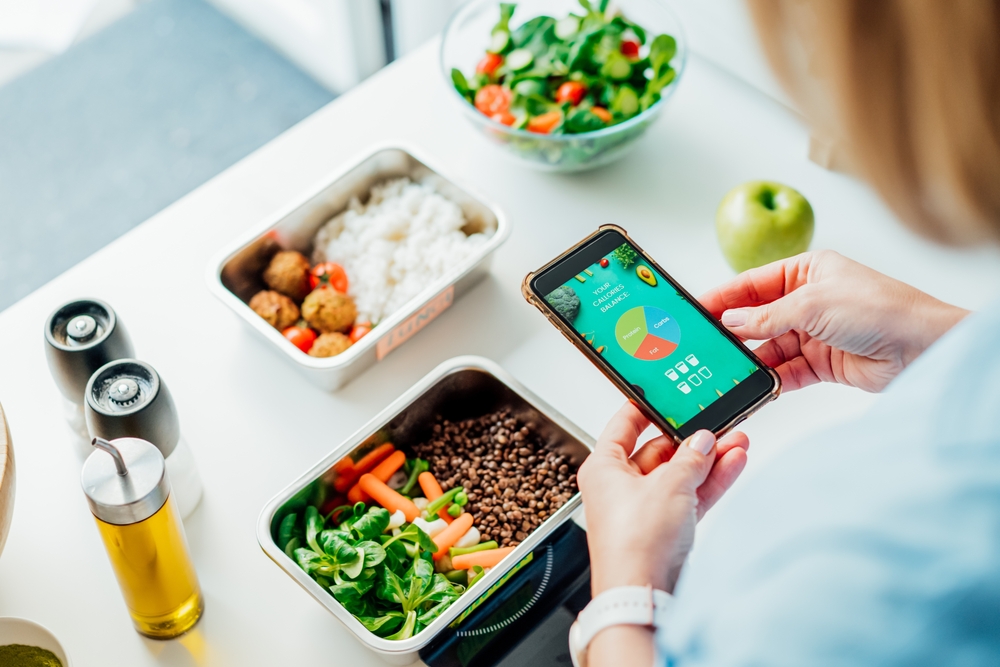
The number of calories you consume is directly tied to weight loss.
So the first thing you need to understand is this:
Calories still count even if you’re not counting them.
If you consume fewer calories than you burn (I.e. you’re in a calorie deficit) then weight loss is a guarantee.
Not losing weight?
You’re not truly in a calorie deficit.
The science speaks for itself on this one.
With that in mind, let me ask you this…
Let’s say you decide not to count calories and you run into a situation where weight loss stops or just doesn’t even happen.
What adjustments should you make regarding your diet to get your weight loss rolling again?
Keep in mind you have no idea how much you’re actually eating to begin with.
It’s like you’re trying to hit a bullseye while blindfolded.
You’d be taking a bunch of stabs in the dark with your nutrition.
But at the end of the day, you have no way to know for sure if the changes you’re making are correct.
That’s where counting calories comes into play.
It gives you a systematic way to ensure you’re eating the amount of food you should be for weight loss.

Let’s say you want to save up some money to buy a new car.
How would you go about that?
You’d get a budget together and track every single penny coming in vs. every single penny going out so you could save as much money as fast as possible.
That’s exactly how counting calories works.
You count calories (budget) to ensure weight loss (save money).
What’s sweet too is that you still have the flexibility to enjoy all the foods you love.
You can have foods like pizza, wings, burgers, fries, cookies, cake, and ice cream.
No food is off-limits.
It’s all about moderation and learning to make more balanced food choices.
Basically, counting calories helps you find that “happy medium” with your nutrition.
You won’t have to keep “starting back up” the diet that helped you lose 15 pounds last time.
(Psssst: Did it really work if you have to start it back up again?)
A diet that allows for your favorites in moderation is infinitely more sustainable.
And what does sustainability lead to?
Results that actually last.
Is counting calories something you have to do forever?
Nope.
But if you’re on the fence about counting calories, especially if you haven’t been seeing much progress in the weight loss department, just try it for the next 2-3 months.
Even if you just do it for a few months, you’ll come away knowing so much more about portion sizes and how to make healthier, more balanced food choices to achieve the permanent results you’re after.
Once you’ve gained that knowledge and built a solid nutrition foundation, maybe you decide to stop counting at that point.
One thing I learned REAL QUICK about counting calories and tracking macros is this:
You’re eating A LOT more than you think you are and that makes staying in a calorie deficit pretty much impossible, considering nutrition is the main driver of weight loss.
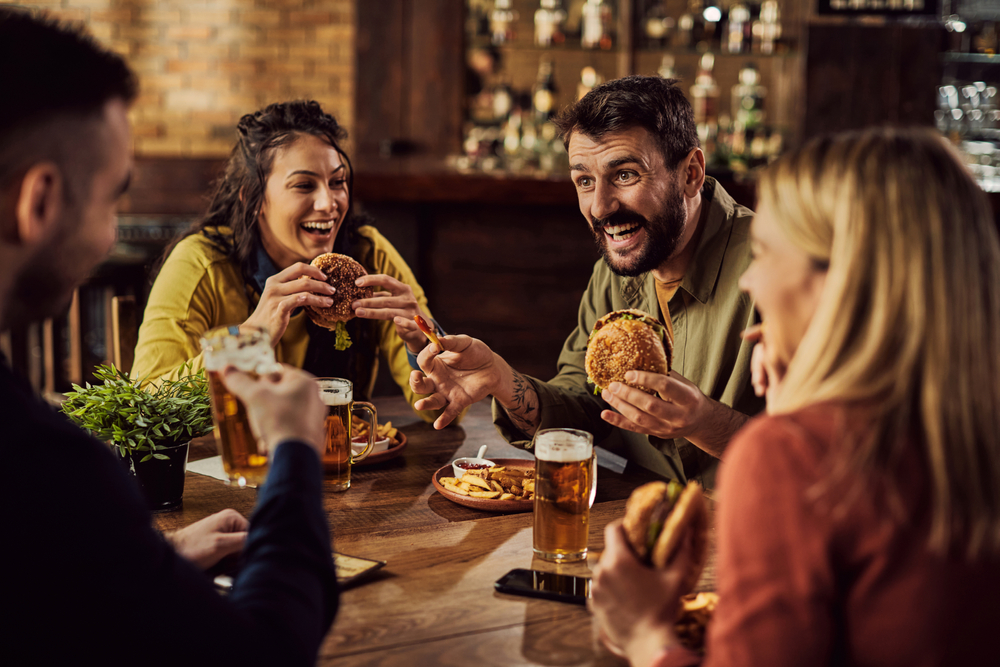
Before we get into specific ways on how to count calories at restaurants I need to set the stageby saying this first…
Perfection isn’t the goal here.
You’re estimating calories when you’re out to eat.
What’s the key word here?
You guessed it…
ESTIMATING.
You count calories at restaurants to just get yourself in the ballpark, keep things under control, and make sure you’re not drastically overeating.
You’re not weighing your food out to the microgram like an accountant balancing a checkbook down to the exact penny.
The truth of the matter is there are so many variables when it comes to eating out at a restaurant that it’s truly impossible to know EXACTLY how many calories are in a certain food or dish.
But the good news is that being perfect doesn’t drive results.
Consistency does.
If you’re not looking at things that way already, I want you to make that shift in your outlook.
At the end of the day…
It’s.
Just.
One.
Meal.
Realize that estimating calories at restaurants isn’t perfect but it’s one thousand times better than the alternative…
Which is to just do nothing.
Something will always and forever be better than nothing.
1. Get nutrition info from MyFitnessPal or online
We’re starting off our list with the easiest and most accurate way to count calories at restaurants.
If you use MyFitnessPal, you can simply just go in and find nutrition information right from the menu for the restaurant you want.
Here’s an example using Burger King:

What if the restaurant where you’re going out to eat isn’t in MyFitnessPal?
A lot of restaurants actually post their calorie and nutrition info online.
You can literally just type something in Google like:
“**insert restraunt of your choice*** nutrition info.”
For example, there’s this BBQ place by my house I couldn’t find nutrition facts for in MyFitnessPal.
But they posted all their nutrition info in a PDF online.
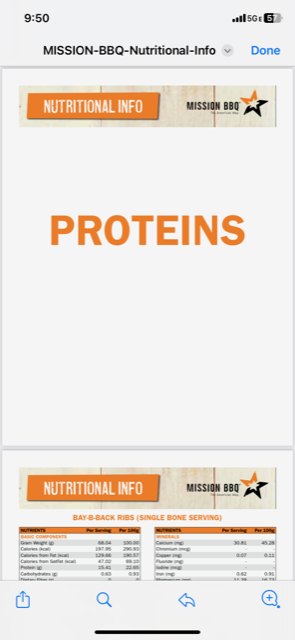
So, again, you can either:
1.) Look up the restaurant directly in MyFitnessPal.
Or…
2.) Just use Google to find their calorie and nutrition information.
2. Find a comparable dish at a similar restaurant
You might run into a situation where you’re eating out on a diet somewhere local and can’t find their nutrition information online.
If that’s the case, no need to sweat.
I have an easy solution for estimating calories when that happens.
All you’re going to do is find the dish or food you want from a similar restaurant and use that.
Or if you want to take estimating calories at restaurants up a notch, you can find two or three similar restaurants with that food and just take the average.
Let’s say you’re out to eat at a local spot.
You want to order 5 mild boneless buffalo wings but can’t find their nutrition information.
But you know what you can find?
Calorie information for two comparable restaurants that also sell boneless wings.
We’ll go with:
- Buffalo Wild Wings (370 calories for an order of 5 wings)
- Buffalo Wings & Rings (426 calories for an order of 5 wings)
(370 calories + 426 calories) / 2 = 398 calories.
That’s what you’d log into MyFitnessPal or whatever calorie-counting app you’re using.
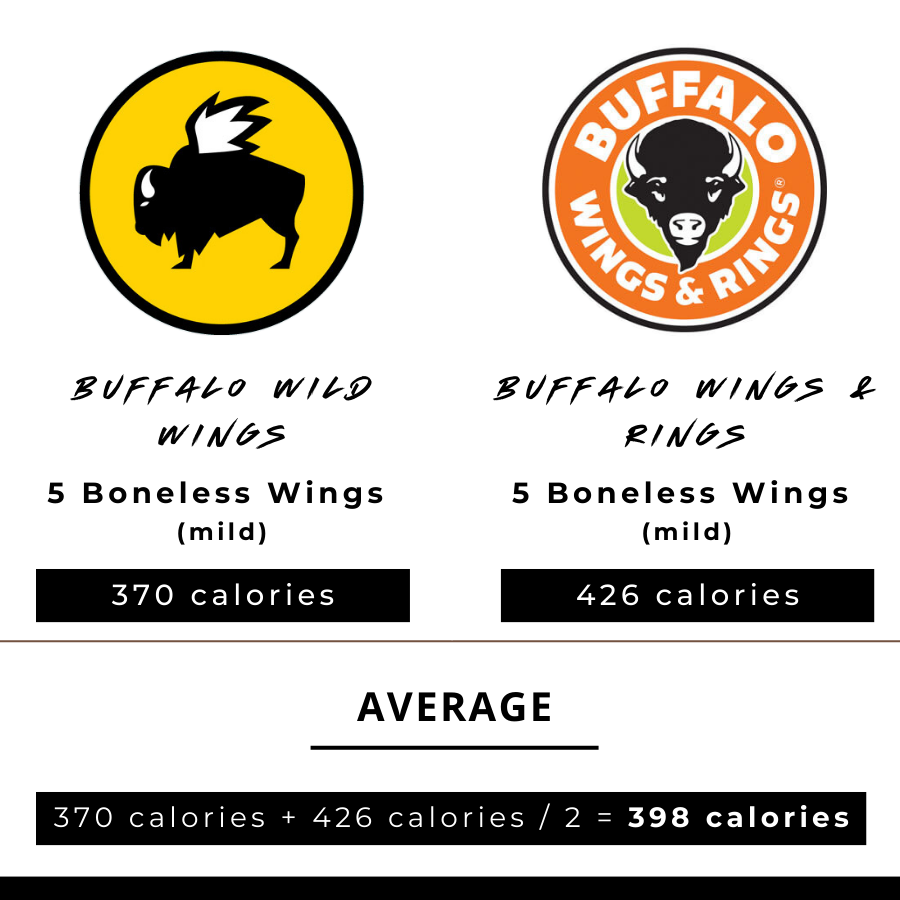
3. The “One Plate” Rule
Let’s say you find yourself in a situation where you’re not able to count calories.
You go to a friend’s house for a potluck.
What should you do?
How do you track all the homemade food?
You can either:
A.) Take a food scale with you and hassle all your friends for every single ingredient down to the exact gram (in which case, there’s a high chance you’ll never be invited back).
Or…
B.) You lean on the One Plate Rule.
My mom always used to say “Assuming makes an ass out of you and me.”
But just this one time I’m going to assume you want option B.
Now, you’re not necessarily “counting calories” with this rule per se.
But what this method does is help you keep your portions under control and your calorie deficit intact.
So in a roundabout way, you’re technically still estimating calories.
The One Plate Rule is this:
You have to be able to fit your entire meal on one plate.
This is not one plate each for appetizers, your main course, and dessert.
This is one plate for the whole thing.
Appetizers + main course + dessert = one plate altogether.
And when I say one plate, that doesn’t mean stacking foods on top of each other like you’re trying to reach the ceiling.
You get one plate, one level.
Nothing’s stacked on top of each other.
Your plate should look like this:
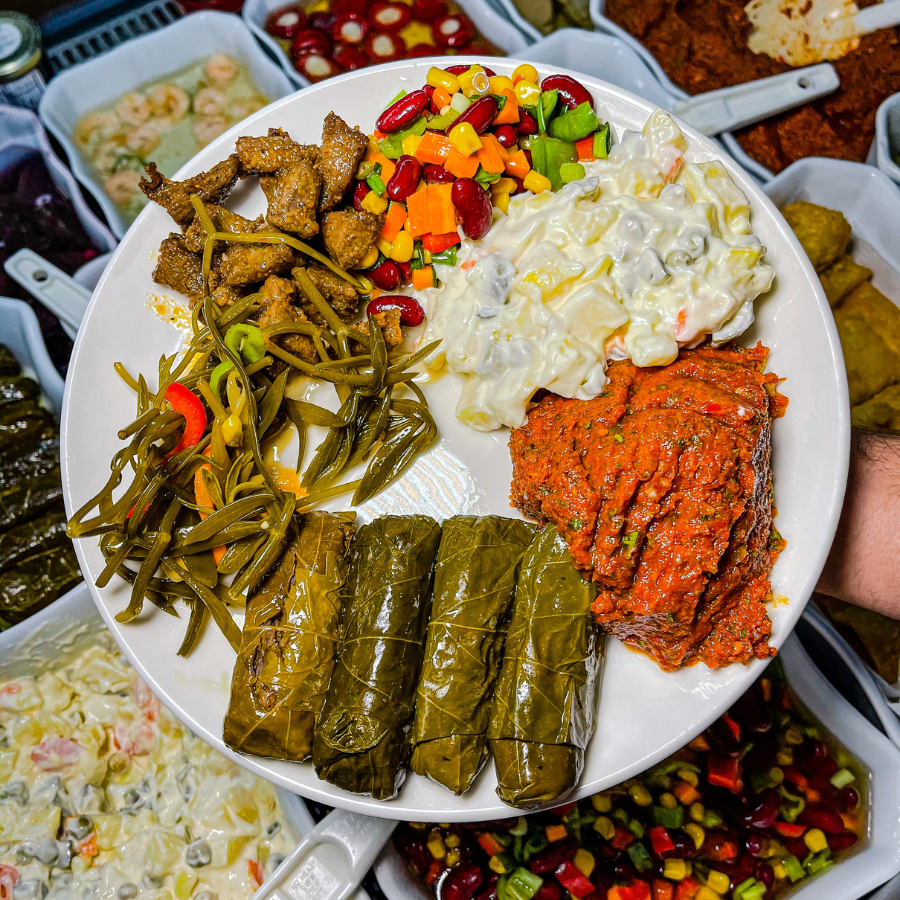
In terms of the number of calories to put in MyFitnessPal, that’s not something you’ll be able to do with this method.
But again, you’re really just focused on keeping your portion sizes reasonable and calories in check with this method.
How to break up your one plate
Ideally, here’s you you want to break up the one plate you’re eating:
- ¼ protein protein
- ½ veggies
- ¼ carbs (this can include fruits too)
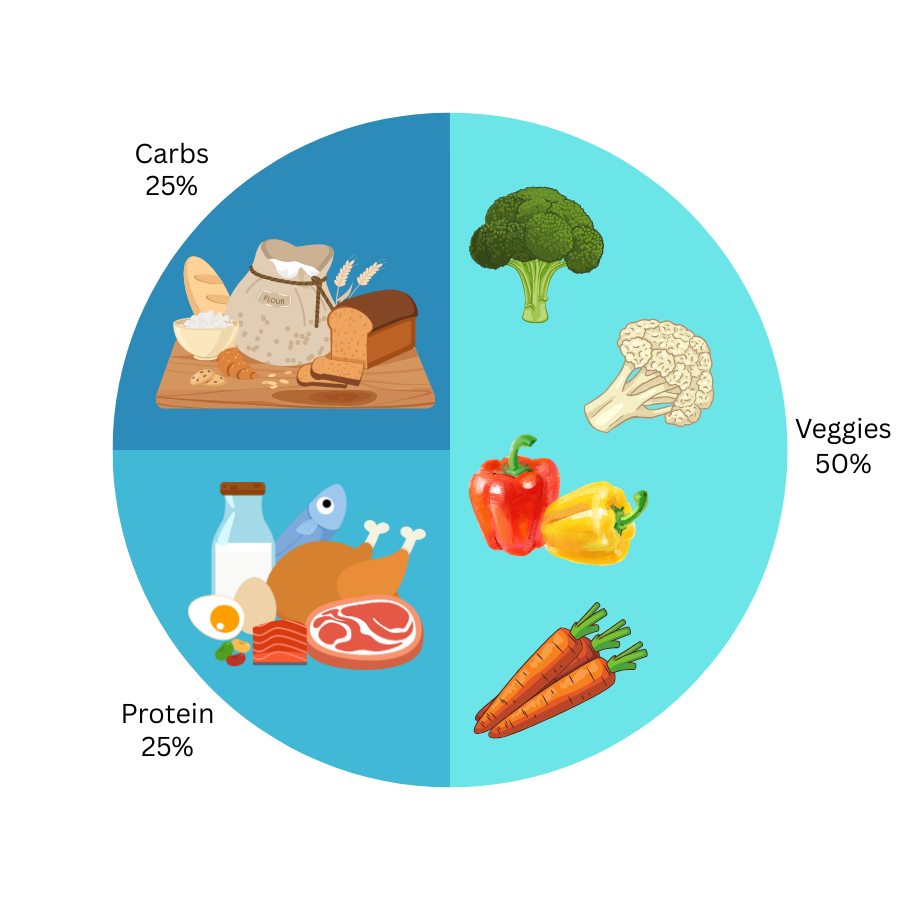
Here’s why the One Plate Rule is so awesome:
- Eating protein fills you up, it’s key to building and preserving lean muscle mass, and it actually increases your metabolism.
- Veggies are a high-volume food (meaning you get to eat a lot of them on fewer calories)
- You need carbs for energy (It’s your body’s main fuel source). And carbs just taste good.
Calorie counting tips for eating out
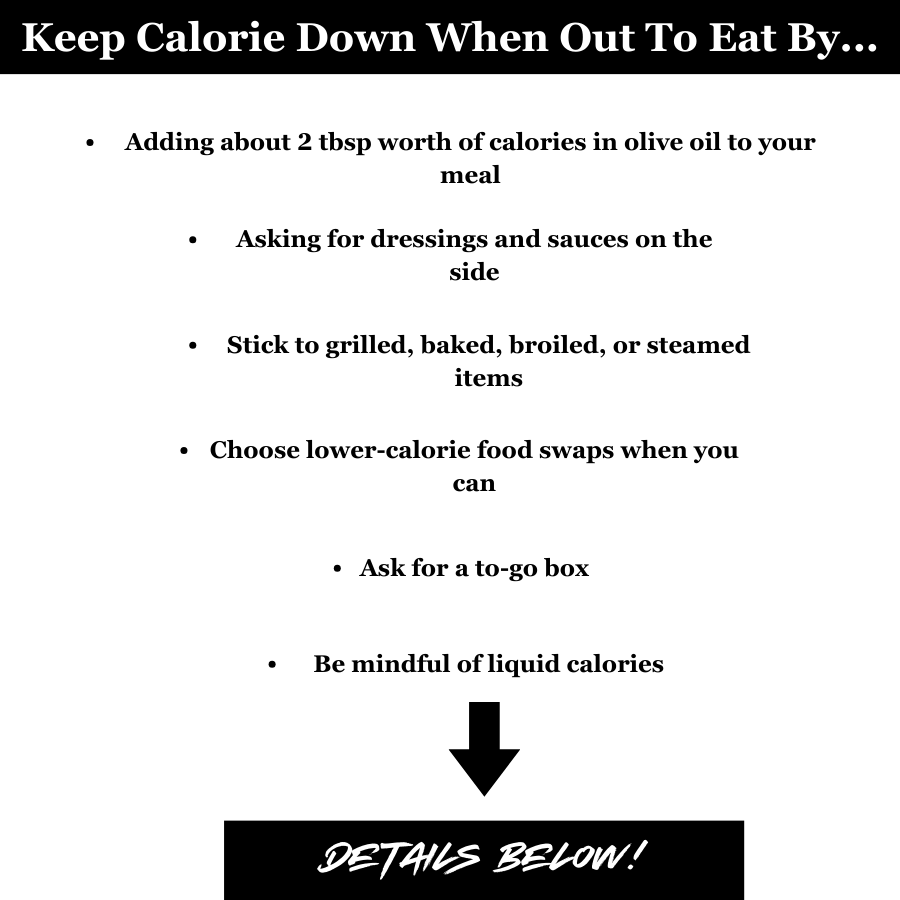
These tips will help you be more accurate when it comes to estimating calories at restaurants and helping you save calories so you can stay on track with your diet:
1. Add in calories for cooking oil
One of the biggest mistakes people make when it comes to their nutrition is not accounting for things like cooking oil (which contain a lot more than most people even realize).
Odds are, the calories you find for a dish, especially if it’s a sit-down restaurant, don’t include the olive oil used when it’s cooked.
Or if it is included, they’re using a lot more of it than they think they are.
Add calories for about 2 tbsp or so of olive oil to be on the safe side when estimating calories at restaurants.
2. Ask for dressings and sauces on the side
It’s a lot better from a calorie perspective to dip your food into sauces or dressings as opposed to drowning your entire plate in it.
3. Go for dishes that are grilled, baked, broiled, or steamed
I.e. grilled chicken or salmon, baked potatoes, steamed vegetables.
You get the idea.
Things that are fried, battered, or smothered (think fried chicken, battered fish, smothered pork chops) come with a higher-calorie price tag.
4. Look for healthier, lower-calorie food swaps to add some balance to your meal
For example, instead of ordering a bacon cheeseburger AND fries, maybe opt for that same burger but get a side order of steamed veggies instead.
5. Ask for a to-go box
A lot of restaurants can double, sometimes even triple up on the portion sizes they serve you.
Before you eat, put half of your meal in a to-go box.
Splitting one meal up into two can save you a good number of calories.
6. Be aware of liquid calories
You know how it is at restaurants.
You keep getting refill after refill and before you know it you’re 3-4 deep.
Keep in mind regular soda and alcohol contain calories, a significant amount at that.
This isn’t me telling you not to drink soda or alcohol.
Just make sure you’re planning for that when counting calories at the restaurant.
FYI, you can always save calories by opting for diet soda (whether as a drink by itself or as a mixer with your alcoholic drink), or water.
One final word about counting calories at restaurants…
I know this whole article has been centered on how to track calories when eating out but here’s the thing…
Don’t feel like you ALWAYS have to.
Sometimes, eating out goes way beyond the calorie count.
You’re celebrating a friend’s birthday.
You got a promotion at work.
It’s a holiday or you’re on vacation.
Don’t worry about counting calories or tracking macros if you don’t want to for occasions like those.
Enjoy yourself, have fun, and simply get back on track when things are over and you’re done celebrating.
Also…
The world won’t end if you go over your calories one meal or have a weekend where you binge eat.
In the grand scheme of things, that’s such a tiny little blip on your fat loss journey it’s not even funny.
A few meals won’t make you extra lean or ripped, the same way a few meals of going over your calories won’t make you fat.
Remember, you’re focused on being consistent, not perfect.
How to count calories at restaurants Q&A
How do you estimate calories in homemade food?
You can create recipes in MyFitnessPal and save them so you’re not having to enter in every single ingredient and the amount you’re eating every single time you have the dish.
In this post, I walk you through step-by-step how to create recipes in MyFitnessPal and count calories in homemade food.
How do you calculate calories in foods without labels?
First, go into MyFitnessPal and find the best option for the food you want.
Sometimes, there will be a description like “medium-sized” apple, “large” apple, and so on.
If possible, try to pick an option with a green checkmark next to it (This means it’s been verified as correct by MyFitnessPal).
Is there an option for you to weigh out that food in grams?
Sweet, do that so you can be as accurate as possible.
But don’t worry if that’s not an option for you.
Just pick the best description for the food you want and log that (i.e. “medium-sized” apple).
I know this isn’t perfect but isn’t that the theme of this article?
You don’t need to be perfect to see results.
You just have to be consistent.
And besides, what’s the alternative?
Just do nothing?
You’re making the best of what you have and playing the hand you’ve been dealt.
What is the app that shows restaurant calories?
I personally have always used MyFitnessPal and I like it a lot so I’d definitely recommend it.
I do know there are other calorie-counting apps out there like Lifesum or Noom but I can’t speak to those since I’ve never used them.
Do restaurants show calories?
Some restaurants will have calorie amounts listed right on their menus, some won’t.
But you can get most restaurants’ (especially chains) calorie and nutrition info online via a quick Google search.
How do you count calories at a buffet?

Remember, your entire meal (appetizers, main course, desserts included) has to fit on one plate.
And if you can, break up that plate like this:
- ¼ protein
- ½ veggies
- ¼ carbs

What's up?
I’m Chad, I’m happy you’re here! I’m a certified personal trainer and my goal is to help you form practical, sustainable habits that lead to lifelong fitness results. If you want to lose fat, build muscle, and live a healthier, happier life then you’re right where you need to be. 💪🏾
Free resources
⬇⬇⬇


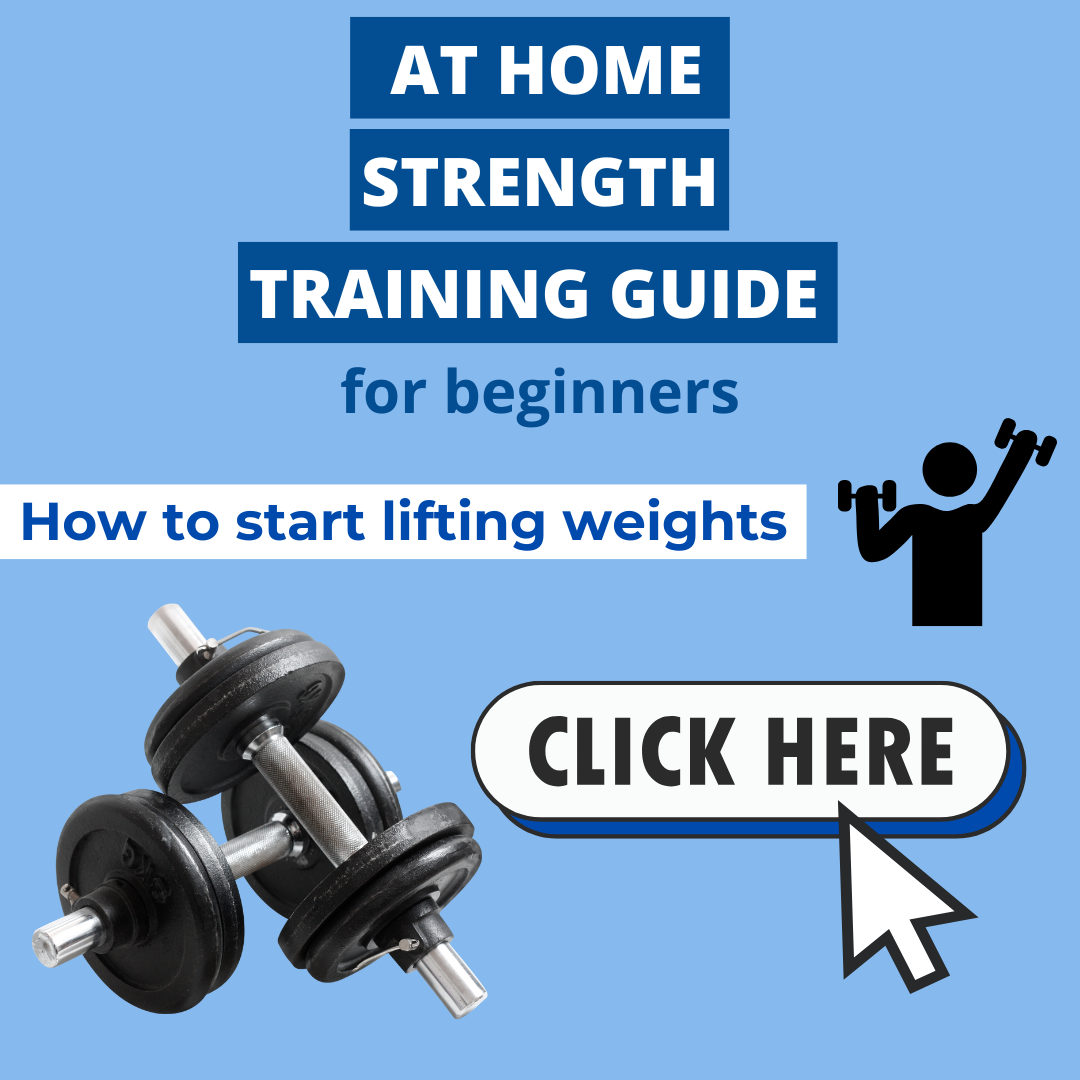


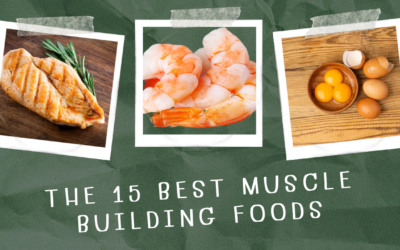

0 Comments